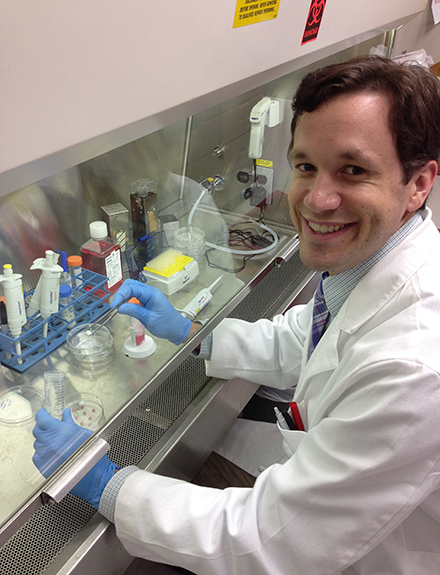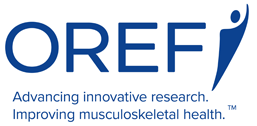

Daniel N. Bracey, MD, PhD
OREF Resident Clinician Scientist Training Grant
Research Topic
Investigating whether a decellularized porcine-derived bone scaffold would be biocompatible, pathogen free, osteoconductive and osteoinductive, making it a possible alternative to autografts and allografts for treating bone defects
Patient Impact
Potential for a xenograft-derived bone scaffold that replaces the need for autografts, which are invasive and painful for patients, and allografts, which potentially trigger immune responses
Xenograft-derived Bone Scaffold Shows Promise
OREF Resident Clinician Scientist Training Grant
Mark Crawford, OREF contributing writer
Segmental bone defects are one of the top challenges for orthopaedic surgeons. Of the five million-plus musculoskeletal surgeries performed in the U.S. every year, nearly half utilize bone grafts.
Autologous bone grafting is considered the best approach for repairing large bone defects because it yields the best results, but it is a very painful procedure and increases patient morbidity. Allografts and xenografts also have drawbacks: foreign cellular material in these grafts may trigger adverse immune reactions in the recipients.
An alternative to bone grafting is the implantation of a xenograft (non-human)-derived bone scaffold that has kept its osteoconductive and osteoinductive growth factors and is free of immunogenic cellular material. This type of scaffold would spare patients the additional morbidity from autografts and reduce the risks associated with allografts. If successfully developed, xenograft-derived bone scaffolds could be in abundant supply—perhaps even as an off-the-shelf product in the operating room.
To explore this idea further, Daniel N. Bracey, MD, PhD, resident-physician scientist with the Department of Orthopaedic Surgery at Wake Forest School of Medicine in Winston-Salem, North Carolina, applied for and received an OREF MTF/ Charles H. Herndon Resident Clinician Scientist Training Grant for a project entitled, “A Novel Xenograft-Derived Bone Scaffold for Improved Treatment of Critical Bone Defects.” Funding was made possible for this grant by the Musculoskeletal Transplant Foundation.
“I am very grateful for OREF’s support, which has been the cornerstone of my funding,” said Dr. Bracey. “If our bone scaffold is successful, it could alleviate the significant morbidity associated with autograft procedures. I truly appreciate OREF’s commitment to research being done by young investigators.”
Bone scaffold decellularization
Because their anatomy, physiology, and genotype are similar to humans, pigs are one of the best xenograft donors. Dr. Bracey is exploring the development of a bone scaffold derived from porcine cancellous bone that is biocompatible, pathogen-free, osteoconductive, and potentially osteoinductive. An essential component of the experiment is a decellularization technology that previous research had shown to be successful.“I was interested in researching topics in regenerative medicine, and specifically in regenerating bone. Decellularization technology has been used previously to make scaffolds for other biological tissues, such as tendons and meniscus, so I thought I would try it with bone,” Dr. Bracey said.
To process a bone scaffold, Dr. Bracey sections a porcine femur, cubes the cancellous bone, and subjects it to a 6-step decellularization process that clears out pig cells and foreign cellular material. Dr. Bracey and his research team then identify the properties and structure of the resulting scaffold.
One aim of the study is to develop a naturally-derived, bio-mimetic bone scaffold with appropriate micro-architecture that is decellularized, cytocompatible, and free of potential pathogens such as bacteria and viruses. Dr. Bracey and his research team use Alpha-GAL ELISA to determine if a significant reduction of the xenoantigen has been achieved. They assess scaffold cytocompatibility with cellular co-culture assays that determine concentrations of inflammatory cytokines. The bone samples carry selected viral and bacterial pathogens to determine if the decellularization process can eliminate them.
Another purpose of Dr. Bracey’s research is to assess the scaffold’s osteoinductive potential by quantifying cell osteogenic differentiation when seeded onto the scaffold using basic phenotypic and gene expression markers.
Bone scaffold potential
Results from Dr. Bracey’s study show that a decellularized bone scaffold matrix can be derived from porcine cancellous bone using the decellularization/oxidation protocol he has developed. For example, a 98-percent reduction in pig bone donor tissue DNA reveals the effectiveness of the process. The matrix is cytocompatible in vitro to exposed cell cultures. Large quantities of the contaminating pathogens were also eliminated.“We wanted to be sure that any pathogens present on the donor material would be removed by the processing technique,” said Dr. Bracey. “We spiked donor material with large quantities of various bacteria and viruses and measured their titers at each subsequent stage of processing. Data showed that no viruses or bacteria were present on the scaffold after completion of processing. This suggests the decellularization technique could be a reliable protocol for processing materials designed for in vivo use.”
Preliminary evidence also suggests the matrix provides an environment conductive to cell growth and may provide certain osteoinductive cues. A mass spectrometry analysis of the bone scaffold found that some residual host growth factors in the pig bone were retained in the decellularized bone scaffold.
“Cells attached themselves to the scaffold and proliferated, as indicated by the significant increase in DNA content over a 15 day period,” said Dr. Bracey. “These cells deposited extracellular matrix components onto the underlying bone scaffold they were seeded to. Overall these experiments show the bone scaffold has some osteoinductive potential because cells were showing evidence of differentiating into osteoblasts.”
Bone scaffold treatment
Dr. Bracey and his team have already taken the next step—an in vivo study using a critical defect rat model. The bone scaffold is being grafted into rat femur critical size defects to assess graft integration, remodeling, and bone healing. Rats implanted with the bone scaffold showed similar remodeling in comparison to rats implanted with demineralized bone matrix (DBM).OREF may also have an impact on this next stage of research. A new physician scientist at Wake Forest’s Orthopaedic Research Laboratory, Dr. Alexander Jinnah, will continue Dr. Bracey’s work as part of his doctorate dissertation over the next two years. “He has applied for OREF funding and I will serve as a research mentor to him,” said Dr. Bracey. “We hope that our research will lead to the successful development of a xenograft-derived scaffold that will have significant clinical and economic impact on the field of orthopaedics, and greatly improve the current management of segmental bone defects.”
